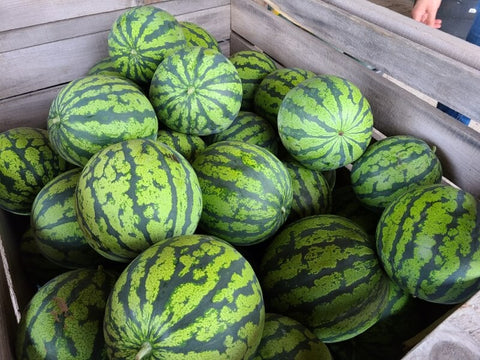
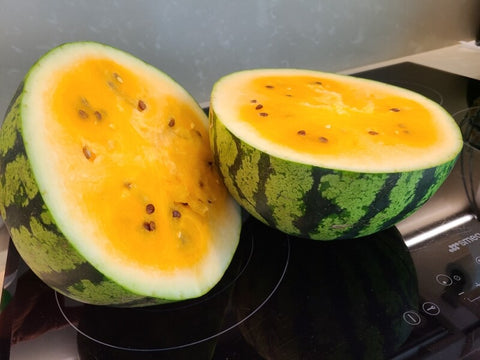
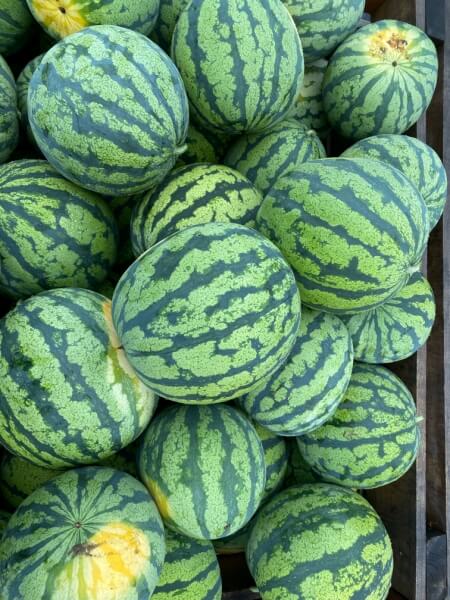
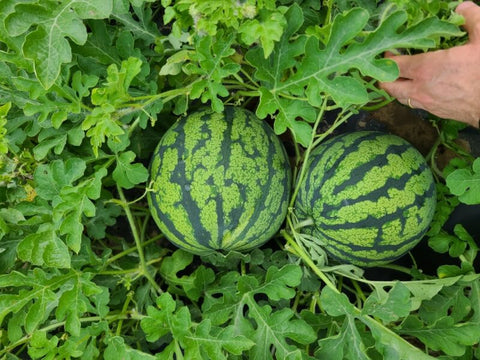
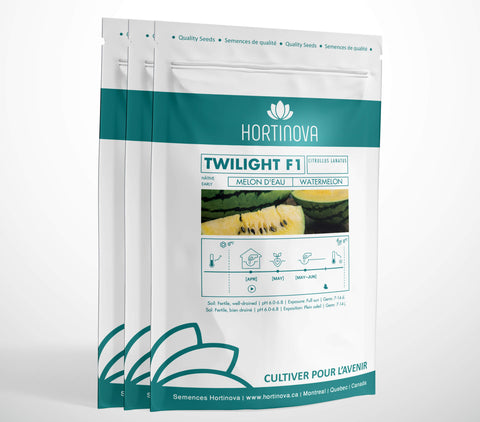
Hortinova
TWILIGHT F1 - Hybrid Watermelon Seeds
Citrullus lanatus
- Early maturity.
- Dragon type watermelon.
- Diploid variety.
- Fruit size up to 12 kg.
- Round shaped fruit
- Smooth rind
- Attractive striped shiny outer skin
- Bright yellow to orange firm flesh.
- Small seeds inside.
- High brix.
- Crisp texture.
- Hybrid seeds.
- Natural, Untreated, Non-GMO Seeds.
For early and reliable crops, sow seeds indoors just after the last spring frost. Plan to transplant seedlings into the garden about 2 weeks after that date or when the soil has warmed to at least 65°F (18°C). In warmer climates with long growing seasons, sow seeds directly outdoors 1 to 2 weeks after your last frost date, as long as the soil temperature has warmed to at least 65°F (18°C). Sow seeds 1/2 to 1 inch deep outdoors or 1/4 to 1/2 inch deep in seed-starting pots indoors. To allow for more root growth, use larger starting pots than you would for most seeds. Also consider using compostable pots that can be cut away or planted directly in the garden, as this will minimize the risk of damaging seedlings’ tender roots during transplanting. If direct seeding outdoors, sow 4 to 6 seeds per hill, eventually thinning to 2 to 3 seedlings.
PLANT OUT: Handle watermelon seedlings with extreme care when you transplant. Their roots are very fragile, so try not to disturb the soil when removing them from pots. Transplant to the field only after the danger of frost has passed and midmorning soil temperatures are regularly at least 65°F (18°C) at a depth of 4 inches. Cooler soil temperatures will delay growth. The seedlings should be spaced 18–24 inches apart with rows 6 feet apart. Watermelons do best in loamy, somewhat-sandy, well-drained soil. They can struggle in soil that contains too much clay and doesn’t drain well. Watermelons need a lot of space—up to 20 square feet per plant. Their vines need room to sprawl, so plant them in a place where they won’t crowd out other crops. Growing the vines in raised rows ensures good drainage.
EXPOSURE: Watermelons require full sunlight in order to thrive. The plants can tolerate some partial shade, particularly in hotter climates, but plenty of sun is necessary to develop the sugars in the melons. Excessively shady conditions will reduce the number and size of the fruits.
WATER: Watering is very important—from planting until fruit begins to form. When transplanting, water with a high phosphorous transplant fertilizer. While watermelon plants are growing, blooming, and setting fruit, they need 1 to 2 inches of water per week. Keep soil moist, but not waterlogged. Water at the vine’s base in the morning and try to avoid wetting the leaves and avoid overhead watering. Reduce watering once fruit are growing. Dry weather produces the sweetest watermelon.
FEED: Amend soil with aged manure, seaweed, and/or compost before planting. Watermelons are heavy feeders, meaning they need soil that is fertile and has a high nutrient level. When fertilizing, make sure to deliver more nitrogen than phosphorus and potassium, as this will encourage leaf and vine growth. However, after flowering begins, use a fertilizer with less nitrogen to instead encourage flowers and fruit.
PROTECT: Mulching with black plastic or straw around the plants will serve multiple purposes: it will warm the soil, hinder weed growth, and keep developing fruits off the soil. After transplanting, cover the plants with row covers to keep pests at bay. Remember to remove the row covers when you see both male and female flowers on the vine, as pollinators will need to access the flowers. As fruit is ripening, prevent rotting by gently lifting it and putting cardboard or straw between the fruit and the soil.
PRUNING: Pruning generally isn’t necessary for watermelon plants, but vine productivity may be improved if you do not allow lateral vines to grow and stick to the main vine. When the plant is young, just cut off the end buds as they form (before the side shoots become vines).
Watermelons don’t continue ripening after they are picked, so harvest time is important. They generally ripen over a two-week period, so keep your eye on them. Thump it. If the watermelon sounds hollow, it’s ripe. Look at the color on the top. The watermelon is ripe when there is little contrast between the stripes. Look at the color on the bottom. An immature watermelon will have a white bottom; a ripe melon will have a cream- or yellow-colored bottom. Stems should be cut with a sharp knife close to the fruit.
Let customers speak for us
from 2 reviewsTRISTAN F1 - Hybrid Summer Squash Seeds

KOSAK - Open Pollinated Red Beet Seeds












